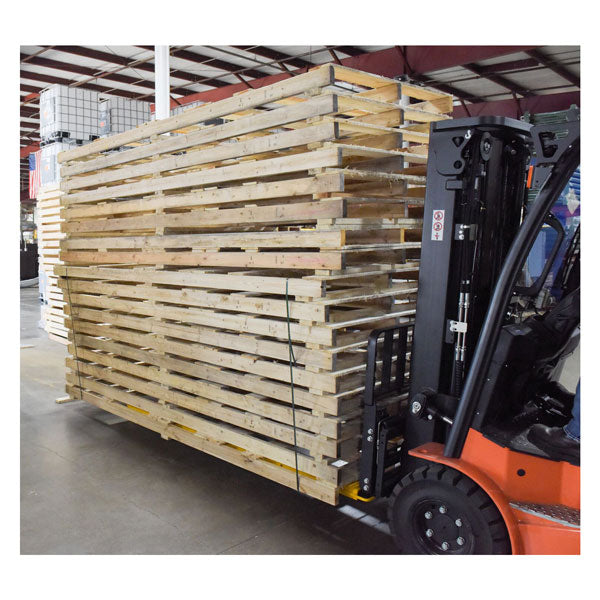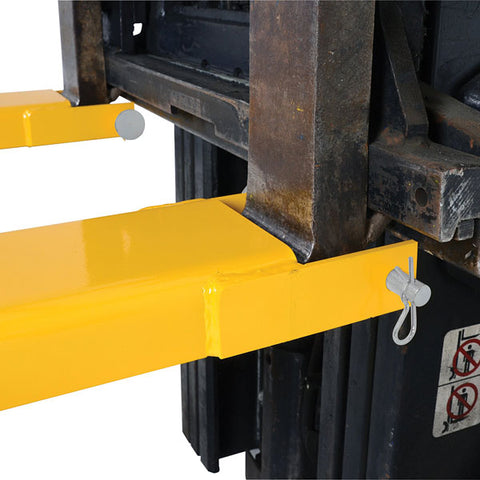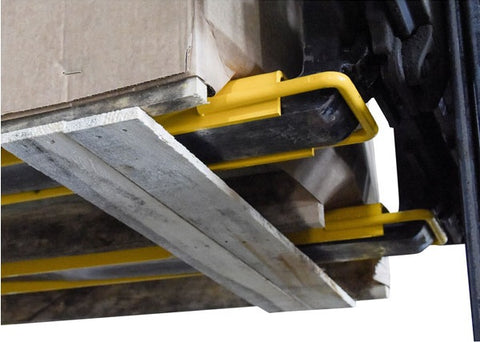Forklifts are incredibly handy machines that can lift loads of all shapes, sizes, and weights. When a load is too long, too heavy, or too awkwardly shaped to raise securely, fork extensions come in help. Fork extensions come in a variety of lengths and widths, adding to the capacity of your forklift. In this article, we'll give a brief review of the many fork extensions that can be employed while also examining their various uses.
Fork extensions are an excellent tool for forklifts and are suitable for various work sites. They are also a more affordable option than buying whole new forks. I'll emphasize important safety elements, issues, and factors including stability, capacity, and visibility for the forklift operator that must be taken into account when employing fork extensions.
In this article, I'll cover:
- Brief Description Of Fork Extension
- When to use fork extensions and why
- Choosing the appropriate length extensions for your needs
- What Kind of Fork Extensions Are Used and How Are They Used
- Forklift Extensions: Safety Suggestions
- Three benefits of forklift extensions for you
- Determine the load capacity of your forklift and follow these short recommendations to lift safely.

A SHORT SUMMARY OF FORK EXTENSION
Fork extensions can be used to address and exacerbate load handling and stability concerns. They may make it possible for forklift operators to handle broader and difficult loads, but doing so also changes the load's center of gravity, which may impact handling, stability, and capacity.
Why does the capacity of a truck alter with different forklift extensions?
This is because shifting the center of gravity of the weight forward increases the overturning moment, which is clearly visible in the forklift abruptly stopping.
While utilizing extensions, make sure to maintain the forklift's load center as close to the back rest as you can, since this will keep it balanced. The forklift load chart will show where the load center is based on that particular model of forklift. Moreover, being aware that the load center cannot extend above the attached extension's length by more than 50%.
FEW ADVICE TO HELP YOU AVOID PROBLEMS RELATED TO USING EXTENSIONS
- Make sure that operators check the fork extensions before every usage and don't utilize any that are damaged.
- The extension's tip should never be used to lift objects.
- Update the forklift plate capacity information to reflect the currently used extension.

HOW AND WHEN SHOULD FORK EXTENSIONS BE USED?
The management of big loads.
Use fork extensions for lifting big items like irregularly shaped pallets or crates and rectangular crates. These loads can be securely handled when employing fork extensions in the proper manner, as using forks of the same size could make them dangerous to hoist.
In these circumstances, it's crucial to reduce risk to the operator and any surrounding passers-by. Knowing when and how to employ fork extensions can promote safety because lifting these irregularly shaped loads can unfortunately make them unbalanced, which increases the risk of the weight falling or the forklift tipping over.
Handling complex and sensitive loads.
Fork Extensions can also be used to lift delicate items like heavy rolls of carpet or fabric that need to be loaded and unloaded with care. Fork extensions can be utilized for heavier weights as well, including rolled steel and aluminum.
Fork extensions can be used to safely operate various objects, such as large furniture pieces, pianos, laminated bonded rolls, and other odd products, that are difficult to manage with normal forks.
For example, hauling two pallets may typically require two journeys, but with the use of fork extensions and provided the pallets are under load weight restrictions, this may be accomplished in just one trip, doubling productivity and halving travel time.
CHOOSING THE PROPER EXTENSION SIZE
The length of extension you can utilize on your forklift can be determined by keeping in mind that it shouldn't exceed the length of the present fork by more than 66%. Similar to length, the breadth shouldn't be more than a half inch broader than the forks now in use. As an illustration, if you employ 63-inch-long forklift extensions, you must ensure that the load center does not extend above the middle's 36-inch limit.
WHAT KIND OF FORK EXTENSIONS ARE USED AND HOW ARE THEY USED?
Fork extensions extend over the forks on a forklift and simply rest on top of the forks. They are easy to slip on and off attachments. It is simpler for the operator to connect and detach the extensions because they are often secured into position by a pin and loop at the end to guarantee they do not slip off when in operation.
TYPES OF FORK EXTENSIONS:
STANDARD FORK EXTENSIONS
These fork extensions are perfect since they maintain the lift truck's agility for standard running while providing greater reach and stabilizing capabilities when needed. Fully rounded toe and heavy duty capping for easy entry into and exit from loads or pallets. Constructed from heavy duty 5mm thick steel with additional 8mm thick internal reinforcement plates. Moreover, it has a detachable pin that enables drive-in entrance, eliminating the need for manual lifting and guaranteeing the security of the fork extensions.
FORK SLEEVE EXTENSION - RADIUS TOP
These fork protection sleeves are constructed from heavy-duty steel that is 8 mm thick and has additional internal strengthening plates that are 5 mm thick. For increased strength, we also include a fully formed profile toe with end cap. For easy pin removal, these extensions additionally have fixed retaining bars. This makes sure that the fork sleeves are securely fastened to the truck forks. Our radius top fork sleeves, which are produced in accordance with ISO 13284 BS, provide the ideal handling option for rolled products where fork edges may cause harm. The fork sleeves will be completely tested and certified to conform with the most recent Health & Safety Standards, just like all of our forklift attachments.
TRIANGULAR FORK SLEEVE EXTENSIONS
Our triangular fork sleeves have all the same features as our heavy duty fork extensions, but they also have an angled face plate that makes it possible to handle cylindrical loads with a forklift without the product rolling off the forks, such as paper reels and cable drums. These sleeves are constructed from heavy-duty steel that is 8 mm thick and have extra internal reinforcement plates that are 5 mm thick. For increased strength, we also include a fully formed profile toe with end cap. Has a replaceable pin that is used when the fork sleeves are longer than 2000mm; this securely fastens the fork sleeves to the truck forks.
Guidelines for Forklift Extension Use Regarding Safety
The possibility of an incident can be decreased by being aware of the risks and potential safety issues that accompany fork attachments.
Forklift tip-overs, overloading the forklift when the weight of the fork attachment starts reducing the lifting capacities, and the potential for falling loads are some of the risks.
Following these safety recommendations will help to ensure forklift safety while in use, particularly when employing attachments or extensions.
- Operators should have sufficient training in fork extension operations and be aware of lifting load restrictions.
- Whenever a new attachment is added, don't forget to retrain the operators.
- Check your forklift attachment every six months for cracks and deformation in the load-bearing sections..
- Make sure the forklift is not overloaded.
- Light, bulky loads are better suited for fork extensions; nevertheless, if the load will exceed the maximum loading center, longer forklifts are preferable.
- Ensure sure the forklift extensions being used are the right width size for the forklift; the width of the fork inside should not be more than 1/2 inch wider than the width of the fork extension.
- Recognize your forklift's restrictions, and don't go beyond them.

3 FAVORABLE FACTORS OF FORKLIFT EXTENSIONS.
- An alternative to buying entirely new forks
- Increases warehouse output (Lifting more awkward loads)
- More advanced features for your regular forklift truck
5 QUICK TIPS FOR SAFER LIFTING AND KNOW YOUR FORKLIFTS' LOAD CAPACITY
The maximum weight that a forklift can securely transport at a given load center is used to calculate the forklifts' load capacity. When the load is off center then the capacity of the forklift will be diminished and fork extensions play a function in adjusting the load center.
As the data plate can be read and the necessary details are provided here, learning about the forklift's capacity and load centers is simple.
Here, you may learn the maximum load each forklift can safely lift when lifting at various mast angles or with attachments. On each plate, the lifting height, load center distance, load capacity, brand, and model number should be displayed.
5 QUICK TIPS FOR LIFTING
- While using scales to weigh loads, be sure to always know their weight.
- Reduce the weight of the load to compensate for a load center that has been exceeded.
- The weights of oversized loads might be estimated.
- Consider purchasing forklift extensions with higher capacities than are actually required.
- Know and understand the forklift's capabilities.
CONCLUSION
In conclusion, fork extensions are simply a more affordable option than buying entirely new forks, and when utilized properly, they can boost workplace efficiency and quicken warehouse movement. They are an easy-to-use product that only requires one person to attach. While making a purchase, it is crucial to take the time to determine which product is best for you and your needs.
We hoped you enjoyed our succinct overview of fork extensions.
Visit our online store to view our selection of forklift attachments. To comply with Health & Safety Laws, we provide Test Certifications with every one of our products.


